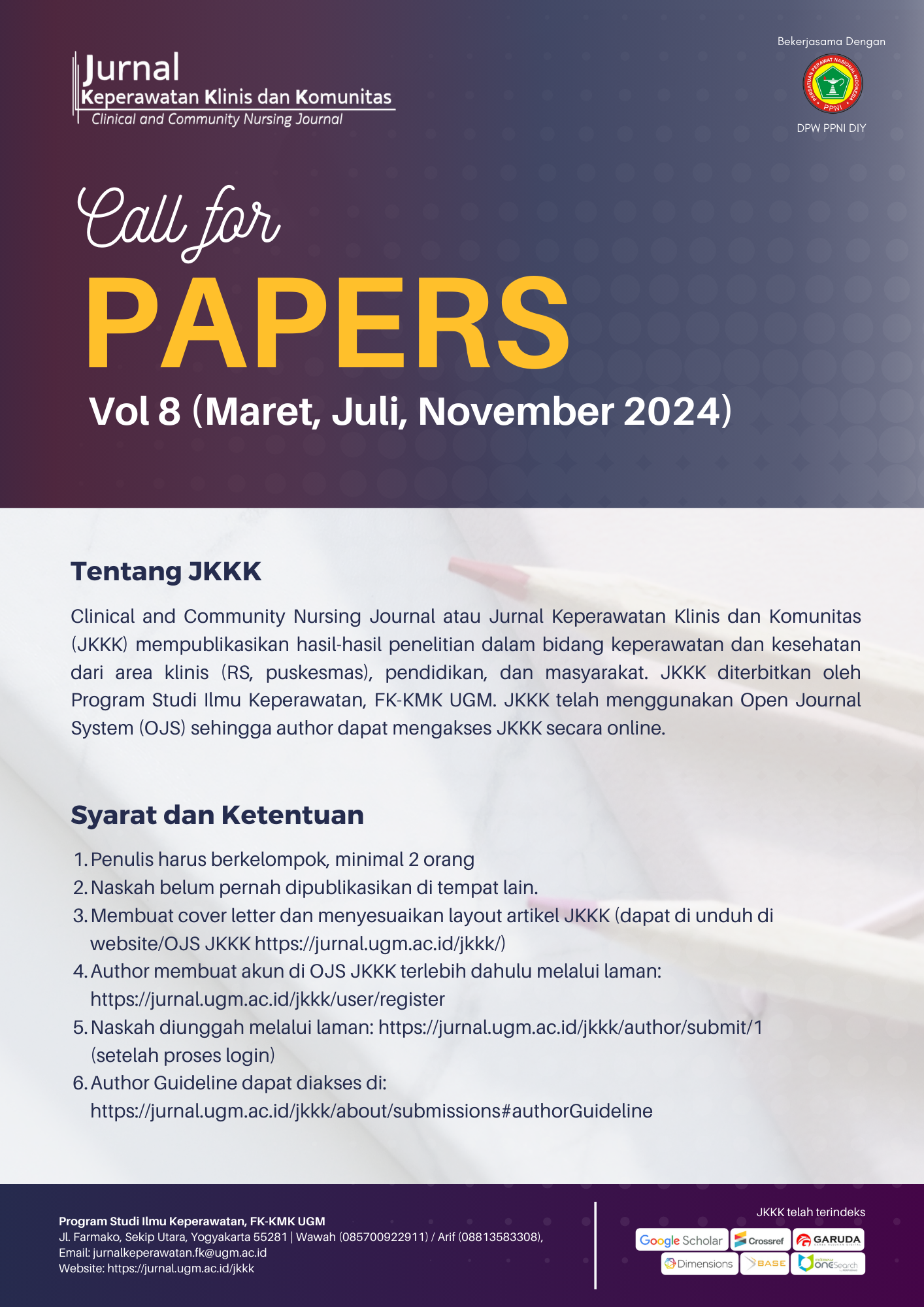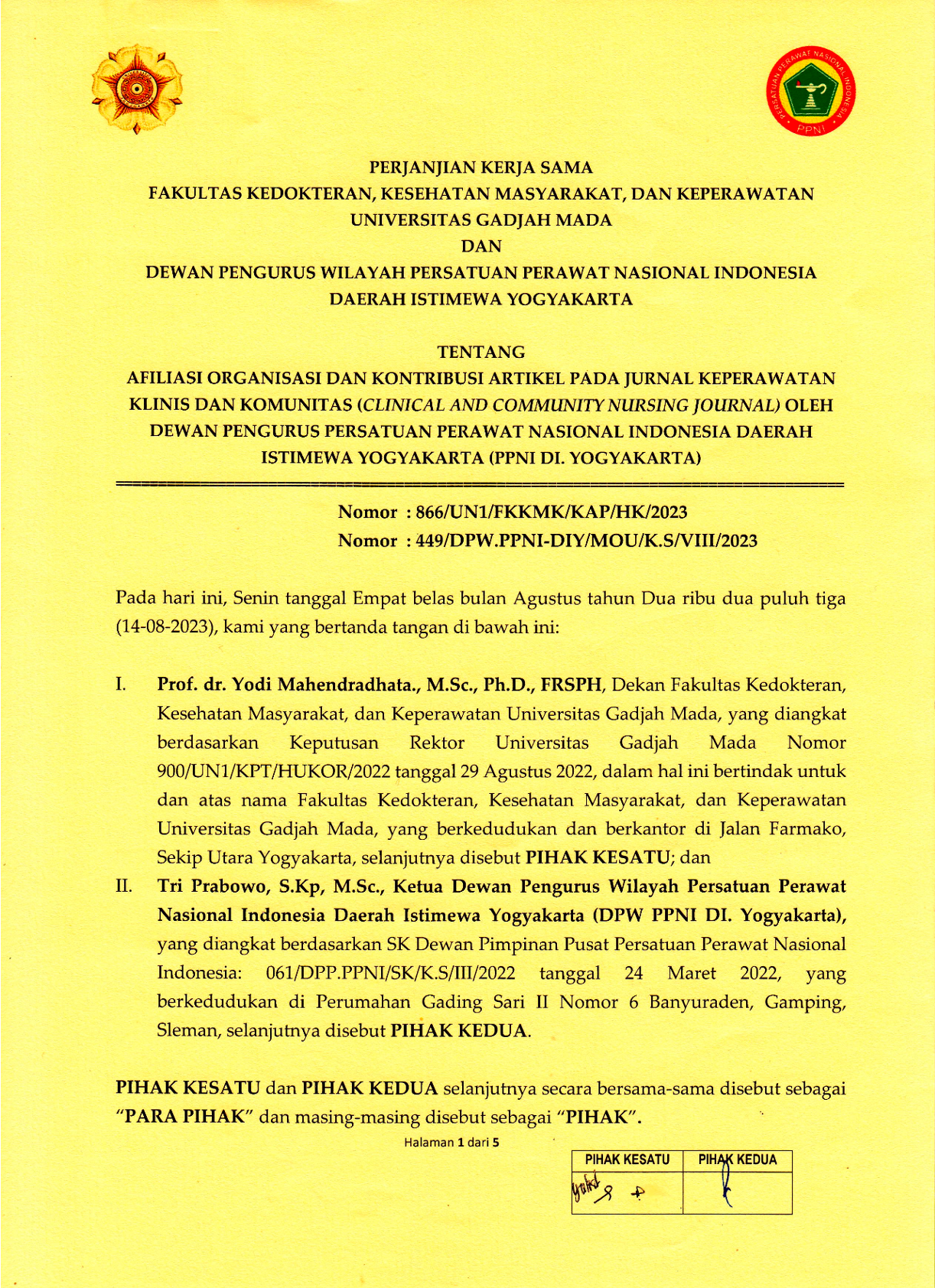Hubungan Dukungan Sosial dengan Kecenderungan Depresi Remaja pada 7 Tahun Pasca-Erupsi Gunung Merapi
Nurul Hasanah(1*), Sri Hartini(2), Anik Rustiyaningsih(3), Carla R Machira(4)
(1) Program Studi Ilmu Keperawatan, Fakultas Kedokteran, Kesehatan Masyarakat dan Keperawatan, Universitas Gadjah Mada
(2) Departemen Keperawatan Anak dan Maternitas, Program Studi Ilmu Keperawatan, Fakultas Kedokteran, Kesehatan Masyarakat, dan Keperawatan, Universitas Gadjah Mada
(3) Departemen Keperawatan Anak dan Maternitas, Program Studi Ilmu Keperawatan, Fakultas Kedokteran, Kesehatan Masyarakat, dan Keperawatan, Universitas Gadjah Mada
(4) Departemen Ilmu Kedokteran Jiwa, Fakultas Kedokteran, Kesehatan Masyarakat, dan Keperawatan, Universitas Gadjah Mada
(*) Corresponding Author
Abstract
Background: Traumatic event can affect victim’s psychological condition, such as adolescent which categorized as vulnerable population, in the form of depression. This hypothetically occurred as the impact of Mount Merapi eruption in 2010. Independent variables for such traumatic condition include gender, age, loss of nearest person, and social support.
Objective: To identify the correlation between social support and depression tendency among adolescent after 2010 Merapi Eruption.
Method: This quantitative study was conducted using descriptive analytic with cross sectional design. Respondents in this study were 50 adolescents who experienced Mount Merapi Eruption in 2010 and living in huntap (Wukirsari permanent residence village). The questionnaires were used in this research, i.e.: socio-demographic questionnaire, Child Depression Inventory (CDI), and Multidimensional Scale of Perceived Social Support (MSPSS). Independent t test was applied to analyze the data.
Results: The prevalence of depression tendency was 24%. There were 54% of respondents who received high social support, while 46% received low social support. The depression tendency had a significant relationship with social support (p= 0,01; p <0,05). Gender, age, and loss of the closest person due to eruption did not have a significant relationship with the tendency of depression, respectively with p= 0,57, p= 0,80, p= 0,07 (p> 0,05).
Conclusion: Social support was the only variable that had a significant relationship with the tendency of depression in adolescents in huntap (Wukirsari permanent residence village).
ABSTRAK
Latar Belakang: Kondisi traumatis dapat memengaruhi kondisi psikologis dalam bentuk depresi pada populasi yang rentan seperti anak usia sekolah. Hal ini yang diasumsikan terjadi sebagai dampak letusan Gunung Merapi tahun 2010. Variabel yang memengaruhi kondisi traumatis ini adalah jenis kelamin, umur, kehilangan orang terdekat, cedera fisik dan dukungan sosial.
Tujuan: Untuk mengetahui hubungan dukungan sosial dengan kecenderungan depresi pasca-erupsi Merapi tahun 2010.
Metode: Penelitian ini merupakan penelitian deskriptif analitik dengan rancangan cross sectional dengan pendekatan kuantitatif. Responden dalam penelitian ini adalah remaja berjumlah 50 orang, yang mengalami erupsi Merapi tahun 2010, dan tinggal di salah satu hunian tetap (huntap). Penelitian ini menggunakan kuesioner karakteristik responden, kuesioner Child Depression Inventory (CDI) dan kuesioner Multidimensional Scale of Perceived Social Support (MSPSS). Analisis data menggunakan uji Independent Sample T Test.
Hasil: Prevalensi kecenderungan depresi pada remaja di huntap adalah 24%. Berdasarkan jenis kelamin, responden lebih banyak perempuan daripada laki-laki yaitu 33 orang (66%) untuk perempuan dan 17 orang (34%) untuk laki-laki. Dukungan sosial yang diterima oleh remaja di huntap yaitu 54% untuk dukungan sosial tinggi dan 46% untuk dukungan sosial rendah. Kecenderungan depresi memiliki hubungan yang bermakna terhadap dukungan sosial (p= 0,01; p<0,05). Jenis kelamin, umur, kehilangan orang terdekat akibat erupsi tidak memiliki hubungan yang bermakna dengan kecenderungan depresi yaitu dengan nilai p berturut-turut p= 0,57, p= 0,80, p= 0,07 (p> 0,05).
Kesimpulan: Dukungan sosial merupakan satu-satunya variabel yang memiliki hubungan bermakna dengan kecenderungan depresi pada remaja di huntap.
Keywords
Full Text:
PDFReferences
- Republik Indonesia. Undang-undang Republik Indonesia Nomor 24 Tahun 2007 Tentang Penanggulangan Bencana. Jakarta: Sekretariat Negara; 2007.
- Widayatun dan Fatoni, Z.. Peran Petugas Kesehatan dan Partisipasi Masyarakat Health Problems in a Disaster Situation: The Role of Health Personnels and Community Participation. Jurnal Kependudukan Indonesia. 2013;8(1).
- Badan Penanggulangan Bencana Daerah Yogyakarta. Gunung Api [Internet]. 2015 [diakses pada 2017 Februari 27]. Diakses dari: http://bpbd.jogjaprov.go.id/web/kontent/64/gunung_api.
- Surono, Jousset, P., Pallister, J., Boichu, M., Buongiorno, M. F., Budisantoso, A., Costa, F., Andreastuti, S., Prata, F., Schneider, D., Clarisse, L., Humaida., H., Sumarti, S., Bignami, C., Griswold, J., Carn, S., Oppenheimer, C., Lavigne, F. The 2010 Explosive Eruption of Java's Merapi Volcano: a ‘100-year’ Event. Journal of Volcanology and Geothermal Research. 2012;241–242:121–135. https://doi.org/10.1016/j.jvolgeores.2012.06.018.
- Any, J., Widodo, B., Ribut, L., & Evi, O. Rapid Assessment terhadap Kerusakan Bangunan Akibat Erupsi Merapi Tahun 2010. Jurnal Sains dan Teknologi Lingkungan. 2011;3(2):115–124.
- Pemerintah Kabupaten Sleman. Up Date Data Perkiraan Rumah Rusak per 26 November 2010 [Internet]. 2010 [diakses pada 26 februari 2017]. Diakses dari: http://www.slemankab.go.id/1651.
- Musa, R., Draman, S., Jeffrey, S., Jeffrey, I., Abdullah, N., Halim, N. A. M., Wahab, N, A., Mukhtar, N, Z, M., Johari, S, N, A., Rameli, N., Midin, M., Jaafar , N, R, N., Das, S., Sidi, H. Post Tsunami Psychological Impact among Survivors in Aceh and West Sumatra, Indonesia. Comprehensive Psychiatry. 2014;55:S13–S16. https://doi.org/10.1016/j.comppsych.2012.12.002.
- World Health Organization. Depression and Other Common Mental Disorders: Global Health Estimates. Geneva [Internet]. 2017 [diakses pada 26 Februari 2017]. Diakses dari: http://www.who.int/mental_health/management/
depression/prevalence_global_health_estimates/en/ - Siu, A. L. Screening for Depression in Children and Adolescents: U.S. Preventive Services Task Force Recommendation Statement. Annals of Internal Medicine. 2016;164(5). https://doi.org/10.7326/M15-2957.
- Lai, B. S., Auslander, B. A., Fitzpatrick, S. L., Podkowirow, V. Disasters and Depressive Symptoms in Children: a Review. Child Youth Care Forum. 2014;43(4): 489–504. https://doi:10.1007/s10566-014-9249-y.
- Hidayat, R. Dampak Kesehatan Mental dan Psikososial Bencana Erupsi Gunung Merapi 2010. Yogyakarta: MPBA UGM; 2011.
- Ardhyani, D. M. Kecenderungan Depresi pada Anak Usia Sekolah Pascabencana Erupsi Gunung Merapi di Kelurahan Glagaharjo Yogyakarta [Skripsi]. Yogyakarta: Universitas Gadjah Mada; 2012.
- Retnowati, S., Widhiarso, W., Investigasi Butir Bias Jender dalam Pengukuran Depresi melalui Children Depression Inventory (CDI). Jurnal Penelitian Psikologi. 2011 [Diakses pada tanggal 2 Juni 2017]. Diakses dari: http://elisa.ugm.ac.id/.
- 14. Zimet, G. D., Dahlem, N. W., Zimet, S.G., Farley, G. K. The Multidimenssional Scale of Perceived Social Support. Journal of Personality Assesment. 1988;52(1):30-41. http://dx.doi.org/10.1207/s15327752jpa5201_2.
- Ibrawansyah, K. Korelasi antara Dukungan Sosial Teman Sebaya dengan Kecenderungan Depresi pada Siswa Kelas 7 SMPN 2 Kecamatan Cangkringan Kabupaten Sleman di Wilayah Bencana Erupsi Gunung Merapi Tahun 2010 [Tesis]. Yogyakarta: Universitas Gadjah Mada; 2016.
- Tang, B., Liu, X., Liu, Y., Xue, C., Zhang, L. A Meta-analysis of Risk FACTORS FOR DEpression in Adults and Children after Natural Disasters. 2014. BMC Public Health, 14, 623. https://doi:10.1186/1471-2458-14-623.
- Masykur, Achmad M. Potret Psikososial Korban Gempa 27 Mei 2006. Jurnal Psikologi Universitas Diponegoro. 2006.
- Retnowati, S. Intervensi Psikososial Saat bencana dalam Prawitasari, JE. Psikologi Terapan: Melintas Batas Disiplin Ilmu. Jakarta: Erlangga; 2012.
- Pan, X., Liu, W. Z., Deng, G. H., Liu, T. S., Yan, J., Tang, Y. X., Dong, W., Cui, Y., Xu, M. Symptoms of Post-Traumatic Stress Disorder, Depression, and Anxiety among Junior High School Students in Worst-Hit Areas 3 Years after The Wenchuan Earthquake in China. Asia-Pacific Journal of Public Health. 2015;27(2),NP1985-NP1994. https://doi.org/10.1177/1010539513488625.
- Tang, W., Zhao, J., Lu, Y., Yan, T., & Wang, L. Mental Health Problems among Children and Adolescents Experiencing Two Major Earthquakes in Remote Mountainous Regions : a Longitudinal Study. Comprehensive Psychiatry. 2016;72:66–73. https://doi.org/10.1016/j.comppsych.2016.09.004.
- Shi, Xuliang., Yu, N. X., Zhou, Y., Geng, F., Fan, F. Depressive Symptoms and Associated Psychosocial Factors among Adolescent Survivors 30 Months after 2008 Wenchuan Earthquake: A Follow-Up Study. Frontiers in Psychology. 2016;467(7). https://doi: 10.3389/fpsyg.2016.00467.
Article Metrics
Refbacks
- There are currently no refbacks.
Copyright (c) 2018 Nurul Hasanah, Sri Hartini, Anik Rustiyaningsih, Carla R Machira

Jurnal Keperawatan Klinis dan Komunitas (Clinical and Community Nursing Journal)
collaborates with DPW PPNI DIY
![]()
Jurnal Keperawatan Klinis dan Komunitas (Clinical and Community Nursing Journal) is licensed under a Creative Commons Attribution-ShareAlike 4.0 International License.




